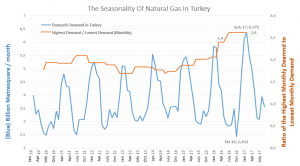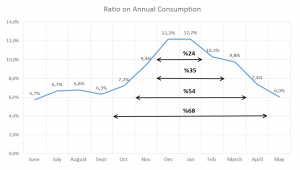 SUMMARY:
SUMMARY:
Seasonality of Turkey’s natural gas demand is a known fact. This Q report will examine this question in two dimensions: The months in which the heating demand is most intense and the gradual shift of the ratio of the months with the highest and the lowest demand. Turkey experiences its highest gas demands in December-January-February months. The lowest demand is observed during the May-June-September months, when power demand is relatively less. The ratio of the demand between these months is gradually increasing.
METHOD:
For this study, data from the international open data source JODI Gas World was used.
The data was separated under terms of seasonality, trends and differences via data analysis programmes. The difficulty here is that in seasonality decomposition, some months are negative and others are positive. Therefore, a constant value is added so that the demand of the entire year is 48 bcm (billion m³).
Another point was the term structure. Because examining the January to December period doesn’t give a clear picture, a 12-month period from June, which is the lowest demand period, to the following May is used.
ANALYSIS:
As demand for natural gas in Turkey increases, the ratio between the high and low demand is gradually increasing.

Given the constraints on natural gas during the previous winter periods, the demand for natural gas has probably been lower than expected. As these problems continue to be solved from 2017 onwards, seasonality will be higher than expected. But because infrastructural problems were solved, the growth in the next few years will follow a natural course.

Historically, the most intense natural gas demand is observed in December-January months. However, there are 5 months of consumption approaching or exceeding 10% of annual consumption. This period is from November 1st to March 31st.
With the investments on natural gas, it is expected that the system will show its real seasonality within the next two years. It points to a sharper demand in December-January. May-September period will have a lower increase in demand. A considerable portion of the gas that is stored within 5 months is drawn in 2-3 months. It also has a demand effect on a calendar year basis at the same time.
CONCLUSION:
The evolution and the development of natural gas demand will be just as important as its seasonality. The most important factor of the seasonality is undoubtedly the demand for heat. Electricity generation from natural gas plants draws the demand even higher. Last year, natural gas had the lowest share in electricity generation in Turkey. Last year was also the year where the demand for natural gas was proportionally the most different.
